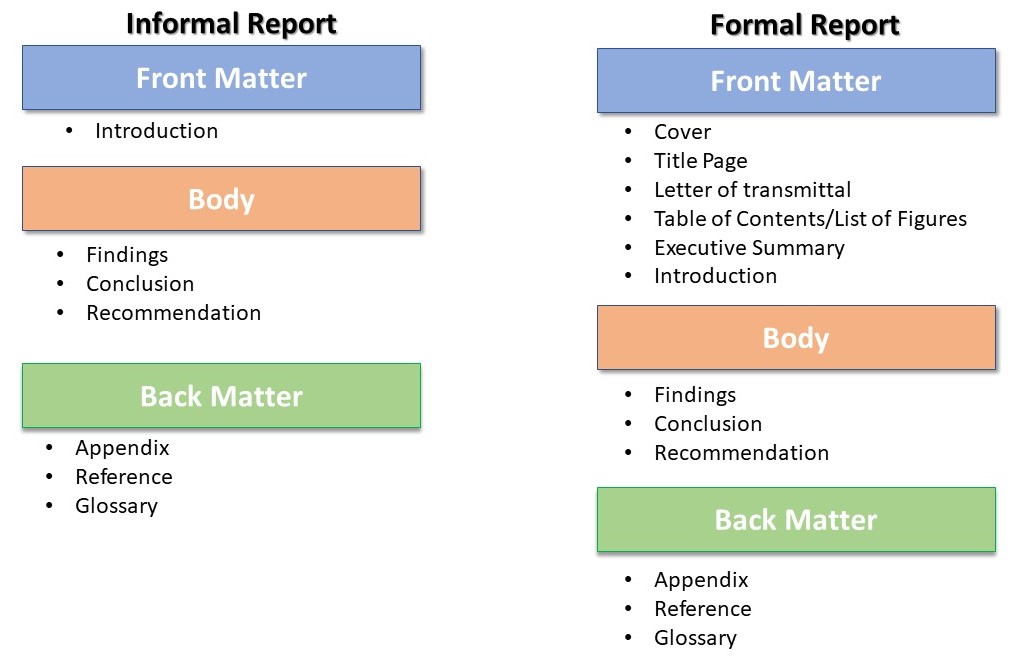Unit 49: Report Parts: Informal and Formal
Learning Objectives
 After studying this unit, you will be able to:
After studying this unit, you will be able to:
-
-
- understand the parts of an informal report
- understand the parts of a formal report
-
Introduction
Informal reports differ from formal reports in their length, purpose, and content. Nonetheless, the parts of an informal and formal report can be divided into three components: front matter, the parts of a report that precede the main body and contain introductory and background information that provides the context for the remainder of the report; body, the presentation of facts, statistics, expert opinion and other forms of research that provide the basis for any decisions made; and back matter, the parts of a report that follow the main body and provides the credentials for the data presented and other supplemental information. Figure 49.1 organizes the parts of an informal and formal report into the three components.
Parts of Informal and Formal Reports

Knowledge Check
To understand the function of each part of an informal and formal report consult Table 49.1. Here the function of each part as well as information on how to compose each part of an informal or formal report is provided.
Table 49.1: Common Formal Business Report Elements
| Part | Function | Example | |
|---|---|---|---|
|
Front Matter |
|||
| 1. Letter of Transmittal | Optional cover letter that addresses the report’s intended recipients and introduces it | See How to Write a Transmittal or Cover Letter (public.wsu.edu) | |
| 2. Cover | Title and image Gives the reader an immediate sense of what the report is all about |
See Papers and Reports templates (Microsoft Office, 2014) | |
| 3. Title fly | Title only Optional |
Feasibility Study of Oil Recovery from the X Tarpit Sands Location | |
| 4. Title page | Label, report, features title, author, affiliation, date, and sometimes for whom the report was prepared. | Feasibility Study of Oil Recovery from the X Tarpit Sands Location Peak Oilman, X Energy Corporation Prepared for X | |
| 5. Table of Contents | A list of the main parts of the report and their respective page numbers. Orients the reader around the scope of the report and helps them find specific information. | Abstract…………….1 Introduction…………2 Background…………3 |
|
| 6. List of Illustrations | A list of figures and tables to help readers locate them. The list may be included as part of the TOC or as its own separate page. | Figure 1…………….5 Figure 2…………….7 Table 1………………3 |
|
| 7. Executive Summary | Presents an overview of the entire report for readers who may not have time to read the details of the full report. | Review the steps and an example of well and poorly developed executive summaries. | |
| 8. Abstract | Enables the reader to get a sense of the entire report at a glance to make quick decisions based on the findings | Learn the strategy for developing informative and descriptive abstracts. | |
| 7. Introduction | Introduces the topic of the report Establishes the context in which the report topic makes sense |
Review these examples of how to write a Purpose Statement and an introduction. | |
|
Body |
|||
| 8. Findings | Most extensive part of the report that presents the facts, statistics and expert opinion included in report. | Use the links to find keys to writing the findings section, including information on integrating graphics, integrating research, and using headers. | |
| 9. Conclusion | Summarizes the key finding presented in the report | Review information and complete exercises on writing a conclusion. | |
| 10. Recommendation | Outlines specific action to be taken to address issues and problems. | Review the recommendation writing process. | |
| Back Matter | |||
| 9. References | List of sources referenced/cited throughout the report | This online module on references provides vital information. | |
| 10. Appendix | Related supporting materials. May include specialized supplemental materials. | Find an overview of creating appendices here. | |
Additionally, the following video provides more information on what information is found in various parts of a report.
Knowledge Check
References
Ashford University. (2019). Integrating research. The writing center. Retrieved January, 19, 2019, from https://content.bridgepointeducation.com/curriculum/file/5408ee9b-e793-44d5-8a4d-e54bc6e72f74/1/Integrating%20Research.zip/story_html5.html
Ashford University. (2019). APA in-text citation helper. The writing center. Retrieved January, 19, 2019, from https://content.bridgepointeducation.com/curriculum/file/9fce9d11-3298-48ef-ac77-12fe7d5c0577/1/In-Text%20Citation%20Helper%20A%20Guide%20to%20Making%20APA%20In-Text%20Citations.zip/story_html5.html
A Research Guide. (2019). How to create an appendix: A guide. Retrieved January 19, 2020, from https://www.aresearchguide.com/make-an-appendix.html
Edraw. (2019). Improve business reports with charts and graphs. Retrieved January 19, 2020, from https://www.edrawsoft.com/improve-business-reports.html
Guffey, M., Loewry, D., & Griffin, E. (2019). Business communication: Process and product (6th ed.). Toronto, ON: Nelson Education. Retrieved from http://www.cengage.com/cgi-wadsworth/course_products_wp.pl?fid=M20b&product_isbn_issn=9780176531393&template=NELSON
Meyer, C. (2017). Communicating for results (4th ed.). Don Mills, ON: Oxford University Press. Retrieved from https://oup-arc.com/access/meyer-4e-student-resources#tag_case-studies
Monash University. (2018). Conclusions and Recommendations. Research and learning online. Retrieved January 19, 2020, from https://www.monash.edu/rlo/assignment-samples/engineering/eng-writing-technical-reports/conclusions-and-recommendations
Thill, V, J., Bovee, C, L., Keller, W, I., & Moran, K, M. (2019). Excellence in business communications (6th ed.). Pearson Canada Inc.
UniLearing (2000). Examples of introduction sections. Report writing. Retrieved January 19, 2010, from https://unilearning.uow.edu.au/report/4biii1.html
UniLearing (2000). Good and poor examples of executive summaries. Report writing. Retrieved January 19, 2010, from https://unilearning.uow.edu.au/report/4bi1.html
University of North Carolina at Chapel Hill. (2020). Abstracts. The writing center. Retrieved Janauary 19, 2020, from https://writingcenter.unc.edu/tips-and-tools/abstracts/
University of Tasmania. (2018). Statement of purpose. Accounting communication matters. Retrieved January 19, 2020, from https://www.utas.edu.au/accounting-communication-matters/writing-an-essay-or-report/starting-to-write/statement-of-purpose
Wordvice Editing Service. (2018). Writing the results section of research papers. Retrieved from https://www.youtube.com/watch?time_continue=7&v=gm9t6WYBSuI&feature=emb_logo
WHO. (2011). Executive summary. Writing effectively for WHO. Retrieved January 19, 2020, from http://colelearning.net/who/module3/page45.html
WHO. (2011). Report conclusion. Writing effectively for WHO. Retrieved January 19, 2020, from http://colelearning.net/who/module3/page40.html

